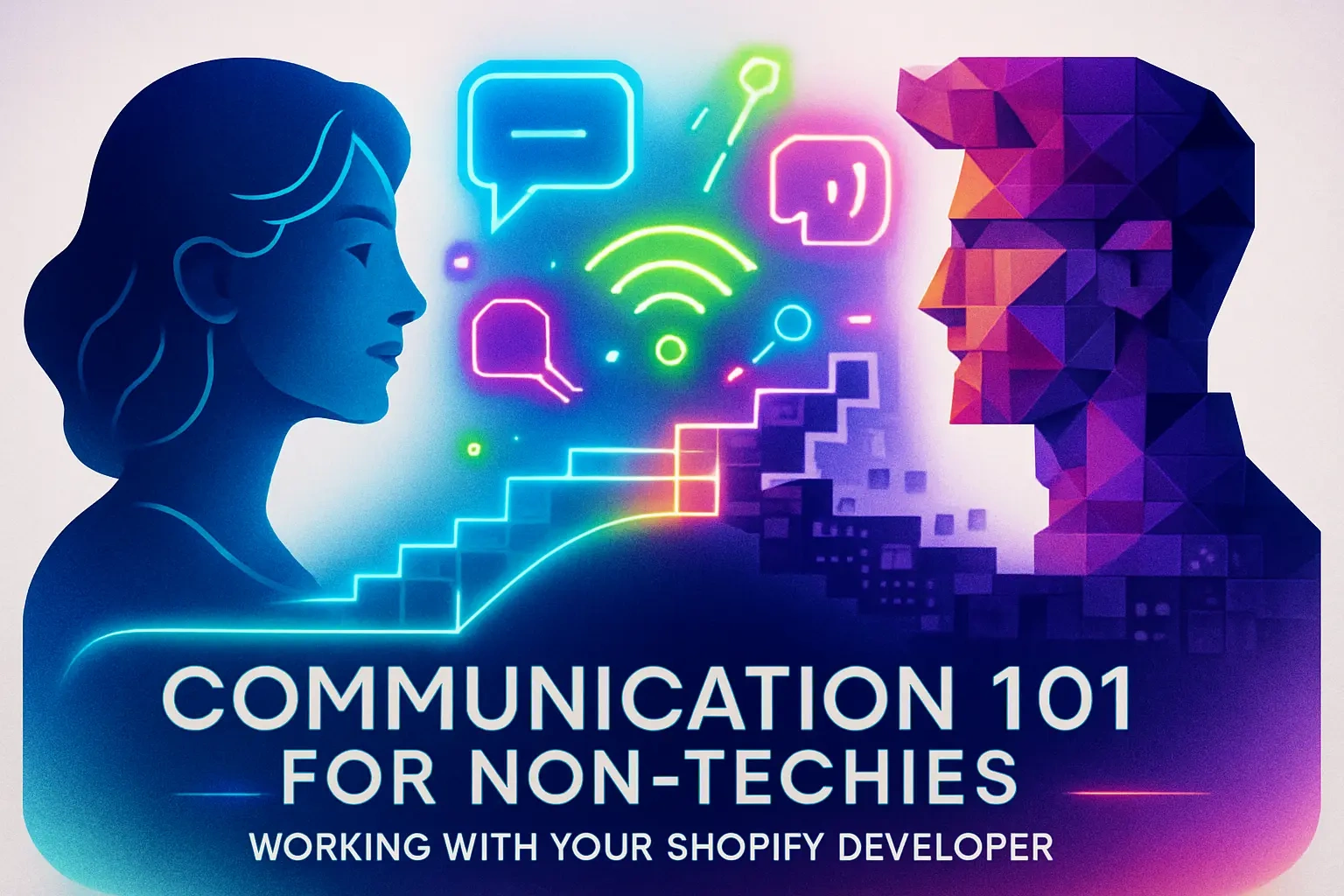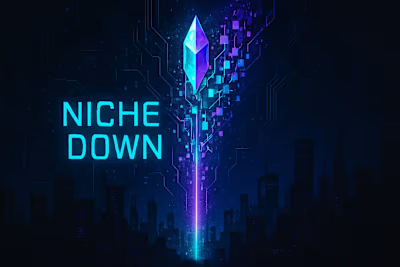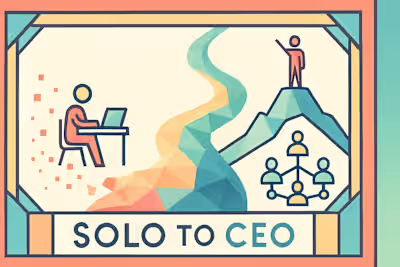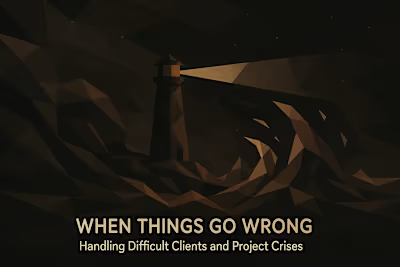Communication 101 for Non-Techies: Working with Your Shopify Developer

Communication 101 for Non-Techies: Working with Your Shopify Developer
Speaking the Same Language (Without Learning to Code)
Use Analogies and Metaphors
Focus on the 'What' and 'Why,' Not the 'How'
Ask Questions and Encourage Them to Do the Same
How to Write Clear and Actionable Requests
Provide Visual Aids: A Picture is Worth a Thousand Lines of Code
Write Clear Acceptance Criteria
Giving Feedback That's Constructive, Not Confusing
Be Specific and Objective
Bundle Your Feedback
Acknowledge Good Work
Conclusion
References
Communication 101 for Non-Techies: Working with Your Shopify Developer
Let's face it - communicating with a Shopify developer when you don't speak "tech" can feel like trying to order coffee in a foreign language. You know what you want, but somehow what you get isn't quite right. The good news? You don't need a computer science degree to work effectively with developers. What you need is a solid communication strategy.
Think about it this way: successful projects aren't built on perfect technical knowledge. They're built on clear communication, mutual understanding, and setting clear expectations from day one. When you nail these fundamentals, everything else falls into place. And with the right collaboration tools in your arsenal, daily interactions become smooth and productive rather than frustrating and confusing.
Speaking the Same Language (Without Learning to Code)
Here's a secret that might surprise you: most developers actually prefer working with non-technical clients who communicate clearly over technical clients who communicate poorly. You don't need to memorize programming languages or understand database structures. What you need is a shared vocabulary that bridges the gap between your business vision and their technical expertise.
The key is finding common ground. When you establish this foundation, conversations flow naturally. Your developer stops feeling like they're speaking to a wall, and you stop feeling lost in a sea of jargon. It's about creating a partnership where both sides feel heard and understood.
Use Analogies and Metaphors
One of the most powerful tools in your communication toolkit is the humble analogy. Technical concepts often have perfect parallels in everyday life. Using these comparisons helps both you and your developer stay on the same page.
Take APIs, for example. Instead of getting lost in technical definitions, think of an API as a restaurant waiter. You (the customer) give your order to the waiter. The waiter takes that order to the kitchen (the server), where the chef prepares your meal. Then the waiter brings your food (the data) back to you. Simple, right?
Here are some other helpful analogies you can use:
A website's backend is like a restaurant kitchen - customers don't see it, but it's where all the magic happens. The frontend is the dining room - it's what customers experience directly. A database is like a filing cabinet - it stores all your important information in an organized way. Website hosting is like renting a storefront - it's the physical space where your business lives online.
These comparisons aren't perfect, but they create a starting point for deeper conversations. When your developer mentions APIs, you can say, "Oh, like the waiter analogy we discussed?" Suddenly, you're both speaking the same language.
Focus on the 'What' and 'Why,' Not the 'How'
This might be the most important shift in how you communicate with developers. Your job isn't to tell them how to code something. Your job is to explain what you need and why you need it. Let them figure out the technical implementation.
Here's what this looks like in practice. Instead of saying, "Add a JavaScript pop-up when someone tries to leave the page," try this: "We're losing potential customers who visit but don't purchase. We need a way to capture their email addresses before they leave, so we can nurture them through email marketing. What do you suggest?"
See the difference? The second approach gives context and explains the business problem. Your developer might suggest a pop-up, or they might recommend a better solution you hadn't considered. Maybe an exit-intent banner would be less intrusive. Perhaps a floating email capture bar would convert better. By focusing on the problem rather than prescribing the solution, you tap into their expertise.
This approach also prevents a common pitfall: asking for something that sounds simple but is technically complex or inefficient. Developers appreciate when you trust their judgment on implementation details. They'll often find creative solutions that achieve your goals more effectively than what you initially imagined.
Ask Questions and Encourage Them to Do the Same
Creating a judgment-free zone for questions is crucial for project success. There's no such thing as a dumb question when it comes to understanding your project better. If your developer uses a term you don't understand, ask them to explain it simply. Most developers are happy to break things down - they just need to know when you're lost.
Try phrases like: "Can you explain that in non-technical terms?" or "What would that mean for our customers?" or "I'm not familiar with that term - can you give me a quick overview?" These questions show you're engaged and want to understand, not that you're clueless.
Equally important is encouraging your developer to ask questions about your business. They might not understand your industry jargon either. When they ask why a certain feature is important or how customers currently handle a task, give detailed answers. The more context they have, the better solutions they can create.
Some developers hesitate to ask business questions because they don't want to seem ignorant about your industry. Break down this barrier by proactively sharing information. Explain your customer journey, your main pain points, and what success looks like for your business. When developers understand the bigger picture, they make better technical decisions.
How to Write Clear and Actionable Requests
Vague requests are the enemy of good development work. "Make it pop more" or "It needs to be more user-friendly" leave too much room for interpretation. The result? Multiple revision rounds, frustration on both sides, and a final product that might still miss the mark.
Clear communication starts with clear requests. Every request should paint a complete picture of what you need, why you need it, and how you'll measure success. This doesn't mean writing novels - it means being precise and thorough.
Provide Visual Aids: A Picture is Worth a Thousand Lines of Code
Words can be tricky, especially when describing visual elements or user interactions. That's where visual aids become your best friend. Screenshots, mockups, and screen recordings eliminate ambiguity and save countless back-and-forth messages.
For design changes, annotate screenshots showing exactly what needs to change. Use tools like Loom or CloudApp to record your screen while explaining an issue. Draw arrows, circles, and add text notes directly on images. Even rough sketches on paper (photographed with your phone) can be incredibly helpful.
When reporting bugs, always include:
A screenshot or video of the issue
The exact steps to reproduce it
What you expected to happen
What actually happened
Which browser and device you used
This might seem like overkill, but it saves hours of debugging time. Your developer can often identify and fix issues immediately when they have visual context. Without it, they might spend time trying to reproduce a problem that only happens under specific conditions.
Don't worry about creating professional mockups. Even basic annotations help tremendously. A screenshot with red arrows and text saying "This button should be blue and 20% bigger" is infinitely better than a text description alone.
Write Clear Acceptance Criteria
Acceptance criteria are your project's definition of "done." They remove guesswork and ensure everyone agrees on what success looks like. Think of them as a checklist that, when complete, means the feature is ready to launch.
Good acceptance criteria are specific, measurable, and focused on user outcomes. Here's an example for a contact form:
Poor acceptance criteria: "Add a working contact form to the website."
Good acceptance criteria:
Users can fill out fields for name, email, phone (optional), and message
Email field validates proper email format before submission
After submission, users see a "Thank you" message confirming receipt
Form data is emailed to admin@company.com within 5 minutes
Spam protection prevents more than 3 submissions from the same IP within an hour
Form is mobile-responsive and works on all major browsers
All form submissions are saved in the database for backup
See how the second version leaves no room for interpretation? Your developer knows exactly what to build, and you know exactly what you're getting. This prevents the awkward situation where a developer says "It's done!" but it doesn't meet your expectations.
Writing good acceptance criteria takes practice. Start by thinking about every interaction a user might have with the feature. What happens when they use it correctly? What happens when they make mistakes? What do you need on the admin side? Answer these questions, and you'll have solid criteria.
Giving Feedback That's Constructive, Not Confusing
Feedback is where many client-developer relationships hit rough patches. Poor feedback leads to confusion, wasted time, and sometimes hurt feelings. Good feedback, on the other hand, moves projects forward efficiently and strengthens working relationships.
The goal isn't to avoid giving critical feedback - it's to deliver it in a way that's helpful and actionable. Developers want to build something you love. Clear, constructive feedback helps them get there faster.
Be Specific and Objective
"I don't like it" is probably the least helpful feedback you can give. It provides no direction for improvement and leaves developers guessing about what to change. Specific, objective feedback points to exact issues and often suggests solutions.
Instead of vague complaints, try this format:
What you're seeing: "The submit button is currently gray and located at the top of the form"
The problem: "This doesn't match our brand colors and users might not see it after filling out a long form"
Suggested solution: "Please change the button to our brand blue (#0066CC) and move it to the bottom of the form"
Notice how this feedback is factual and focused on specific elements? It's not about personal preference - it's about brand consistency and user experience. This approach helps developers understand both the issue and the reasoning behind requested changes.
When something isn't working, explain the impact. "The page loads slowly" is good. "The page takes 8 seconds to load, and our analytics show users leave after 3 seconds" is better. This context helps developers prioritize fixes and understand the business impact of technical issues.
Bundle Your Feedback
Imagine trying to cook dinner while someone keeps popping into the kitchen with new instructions. "Oh, add more salt. Actually, can you use olive oil instead? Wait, let's make it spicier." This constant interruption makes it impossible to focus and finish the meal.
The same principle applies to development work. Sending feedback as soon as you think of it might seem efficient, but it's actually disruptive. Developers need focused time to code, and constant interruptions break their concentration.
Instead, collect your feedback over a day or two, then send it as one comprehensive list. Use a shared document where you can add notes as you review the work. When you're ready to send feedback, organize it by priority:
Critical (blocks launch):
Payment processing isn't working
Mobile menu doesn't open
Important (should fix before launch):
Contact form confirmation email has typos
Product images are blurry on retina displays
Nice to have (can address later):
Animation could be smoother
Would prefer different hover effect on buttons
This approach lets developers tackle the most important issues first. They can plan their work efficiently instead of constantly switching between tasks. You'll get better results faster, and your developer will appreciate the organized approach.
Acknowledge Good Work
Here's something many clients forget: developers are human beings who appreciate recognition. When something works perfectly or exceeds expectations, say so. Positive feedback isn't just nice - it's practical. It reinforces what's working and builds a stronger relationship.
Simple acknowledgments go a long way:
"The new checkout flow is exactly what we envisioned - great work!"
"I love how you solved the mobile navigation problem"
"Thanks for suggesting that alternative approach - it saved us time and money"
Be specific with praise just like with criticism. "Good job" is nice, but "The way you implemented the search function is brilliant - it's so much faster than our old site" is better. This specificity shows you're paying attention and genuinely appreciate their expertise.
Positive feedback also creates psychological safety. When developers know you'll acknowledge good work, they're more likely to suggest creative solutions and go the extra mile. They're also more receptive to constructive criticism because they trust that you're fair and balanced in your assessments.
Remember to share positive customer feedback too. When a customer compliments the site's functionality or ease of use, pass that along to your developer. It connects their technical work to real-world impact and reminds them why their work matters.
Conclusion
Working with a Shopify developer doesn't require you to become a technical expert. What it does require is clear communication, mutual respect, and a willingness to bridge the gap between business needs and technical solutions. By using analogies to explain complex ideas, focusing on outcomes rather than implementations, and providing specific, visual feedback, you create an environment where great work happens.
Remember, your developer wants to build something amazing for you. They're not trying to confuse you with jargon or make things complicated. Most communication breakdowns happen not because of technical complexity, but because of unclear expectations and vague requirements.
Start implementing these strategies in your next developer conversation. Use visual aids for your next feature request. Write clear acceptance criteria for your next project milestone. Bundle your feedback instead of sending it piecemeal. These small changes will transform your working relationship and lead to better results.
The best client-developer relationships feel like partnerships. You bring business expertise and vision. They bring technical skills and creative problem-solving. When you communicate effectively, these strengths combine to create something neither could achieve alone. That's the real magic of great collaboration - and it all starts with communication.
References
Like this project
Posted Jul 4, 2025
Bridge the communication gap with your developer. Learn how to explain requirements clearly, provide effective feedback, and use analogies to foster a successful partnership.









